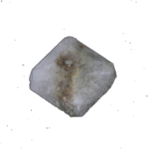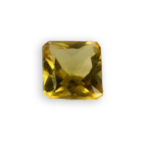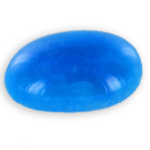
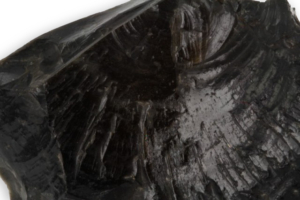
obsidian
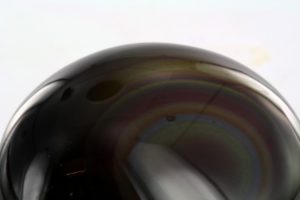
rainbow obsidian from Mexico
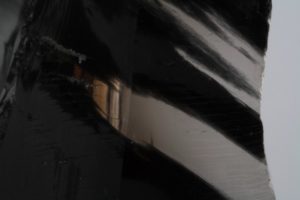
Armenian obsidian black colored by magnetite nano-crystals
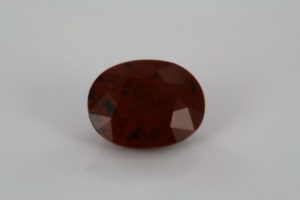
cut mahohany obsidian
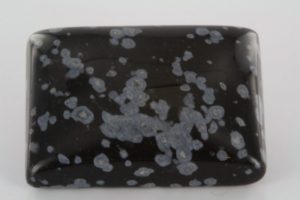
obsidian snowflakes from Africa
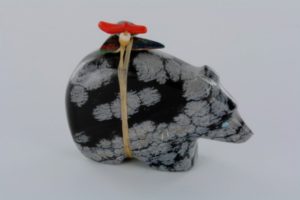
Zuni fetish in obsidian snowflakes from the U.S.
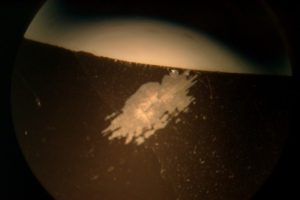
solid like inclusions, cristobalite
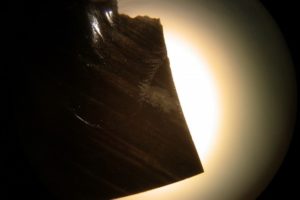
sharp fracture with solid inclusion

solid inclusions in snowy obsidian
Detailed sheet
obsidian
Its name comes, according to Pliny, from Obsidius who brought it from Ethiopia, which would have led the Romans to call it “obsidius lapis”.
From the seventeenth century we find the names of hyalopsite, mountain mahogany, Iceland black agate, mirror of the Incas, gallinaceous stone …
It was first classified among the rocks and among the “hard stones” by Brongniart.
Haüy, who acknowledged his origin, called it “glassy lava obsidian”.
Overall, this is a volcanic glass, composed of tectosilicates, which is formed by rapid cooling of a magma in which the dispersed atoms in the melt, did not have the time to order in the crystal system: it is the vitrified form of rhyolite.
We find several varieties:
snowflakes obsidian, like snowflakes, in flowers, whose interior is dotted with gray spots, which comes mainly from Mexico and the United States,
gold or silver obsidian, which has stains of that color,
the celestial eye obsidian with iridescent concentric purple-gray or pale green zones,
the apache tears, which are only small “drops” of volcanic glass 1 to 2 mm in diameter and 3 to 5 cm long.
Some books indicate a “flowering obsidian” which comes from Oregon, rust-colored or bronze spotted with black or silver, more or less iridescent .
The rainbow obsidians having all the colors of the rainbow, due to the needles of hedenbergite and come from Mexico.

CHEMICAL CHARACTERISTICS
SiO2
amorphous mineral glass

PHYSICAL CHARACTERISTICS
Main color
black
Other colors
brown, grey, colourless, yellow, red, green
Variable color, usually black but sometimes dark gray, which can tend towards the rusty brown to dark red.
Color of streak
white
Luster
vitreous
Hardness
5.0 to 5.5
Density
2.35 to 2.60
Cleavage
none
Fracture
conchoidal, splintery
splinters with very cutting sharp edges

OPTICAL PROPERTIES
Transparency
translucent, transparent
on the edges of the break, where they are less thick, it may be clear, transparent.
Refractive index
1.450 - 1.500
Double refraction
0.000
none it’s a volcanic glass
visible double refraction
No
Dispersion
0,010
Pleochroism
absent
Number of colors
1
Fluorescence
none
Inclusions
volcanic dust, traces of fusion, gas bubbles, small crystals: feldspars, cristobalite

CRYSTALS PROPERTIES
crystals system
amorphous

OTHER INFORMATIONS
Astrological sign
Aquarius, Aries, Libra, Pisces, Taurus

APPROACHING GEMS
Exploited
sites
It is found near some volcanoes, in activity or dead, or off the edge of the cast or on their surface, in Mexico (many deposits such as the mountain of knives, evocative name), in Ecuador (volcano Antisama), in Greece (Milos and Santorini), Japan, Indonesia, New Zealand, Iceland (Mount Heckla, Midsandsà valley …), in Russia (Kamchatka region), in Italy (Lipari Island).
In the United States we can include Arizona (Gila region), Oregon (Mutton Mountains), Colorado, California “Silver Cliff,” in Wyoming, at Yellowstone Park where we can see a mass of about 40 m thick and 1.6 km long, resembling as pumice on the top and where, exceptionally, it shows a kind of … prismation … and in Hawaii.
In France we know some small veins in the Puy de Dome (Planches caves near Lusclade ), in Cantal, in Haute-Loire …
use in jewelry
Since ancient times it was used to make weapons, arrowheads, knives, mirrors, tools, filters from the sun. Today, some masks and ornaments in Mexico … some artists, including Karl Faberge and George Wild, carved animals (fish, seals, elephants …), taking advantage of the orientation of the reflections of the stone to mimic scales or fur. to notice that in the United States, some businesses after World War II to the west of the Rockies, came to produce 200,000 tonnes per year. the stone, heated rapidly, loses its water, its volume increases up to twenty times, and it is sprayed to mix with plaster and get a lightweight, noncombustible product. This process is widespread in Northern Ireland and in Europe.
Daily care
and precautions
Sensitive to shocks that cause splinters, it is resistant to household products but can be scratched with a knife.
imitations and
treatments
It is imitated by artificially tinted glasses.
Historical
healing properties
Some advise to place a piece of obsidian on the root chakra and an uncut quartz crystal above the head, its tip pointed at the top of the skull. This would cure the weaknesses of external vision, dissolving blocked emotional structures, reinforcing the possibility of solving our emotional problems, our inner vision of truth.
It would be a strong bond with earth, anchored to reality, building around the person a protection zone allowing him to focus and meditate better. It plays a powerful role against negative energies and influences. Its properties would help cutting the darkness and give access to the light of knowledge, driving away the myths, fantasies, illusions. Some of its varieties will possess specific properties: for example, black obsidian flecked with white, image of the very pure night sky, would bring the right balance between the material and the spiritual.
The celestial eye obsidian is the most effective of all because, in balls or cabochon cut, it would become the cradle of all the positive energies and confer maximum protection, helping to raise the mind towards the upper layers of the spiritual.
Correspondence with the chakras as a black stone: the first chakra, root chakra / base chakra. It is often used at the first chakra or at the feet, when meditating, with a blue or purple stone on the upper chakras in order to maintain contact with the Earth. Correspondence with the zodiac signs vary with the authors …
Signs in Indian astrology, according to Sun Bear Medicine Wheel: Wapiti, from November 22 to December 21.
historical stones
and related legends
Prehistoric people had observed that the size of this natural glass chips gave sharper edges than those of flint for their weapons (arrowheads) and tools (knives, scrapers). They also crafted necklaces and pendants, maybe also invested with magical powers.
Some bifacial arrowheads were shaped by the ancestors of the Japanese 11 000 years ago. The people who succeeded them knew how to capitalize this knowledge at their turn, like the Hittites (in 7000 BC they polished mirrors), Jews and Muslims were using the blades for circumcision. Pre-Columbian civilizations (Aztecs, Mayans, Olmecs, Incas …), living in volcanic areas had also noticed this stone and they also made weapons and tools (including knives to tear out the heart of the sacrificed), the so-called magic mirrors (“mirror of the Incas”), and masks.
The islanders from Easter Island have left the remains of a very advanced industry. Even now, there is a whole industry of traditional objects (statues, skulls, small masks …) that are produced locally and sold to tourists or exported to Latin America.
The legend of Apache Tears: during the days of the Wild West, the fighting between the apaches and white men were fierce. The soldiers decided to hunt down the apaches into their camp in Arizona to exterminate them. They killed many of the Apaches by surprise … the few survivors and the women fled into the mountains up to a cliff which left them no chance to flee … all the apache warriors preferred to jump from the top of the cliff rather than surrender. It is said that the Great Spirit moved by the tears of women and children who stayed for one moon to mourn their husbands and fathers, turned their tears in black beads to help keep the memory of this tragedy.
Venez visitez
notre site web
voillot-joaillier.fr
Lorem ipsum dolor sit amet, consectetur adipiscing elit. Ut elit tellus, luctus nec ullamcorper mattis, pulvinar dapibus leo.Lorem ipsum dolor sit amet, consectetur adipiscing elit. Ut elit tellus, luctus nec ullamcorper mattis, pulvinar dapibus leo consectetur adipiscing elit. Ut elit tellus, luctus nec.


